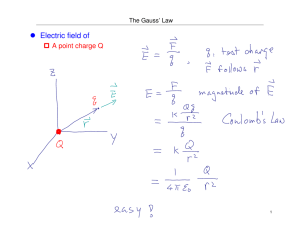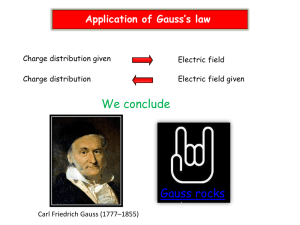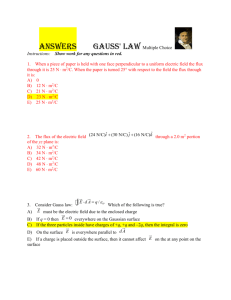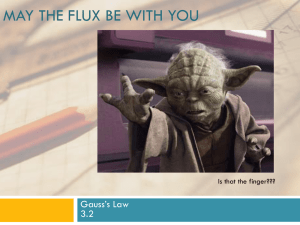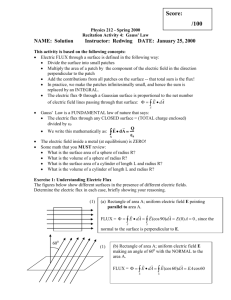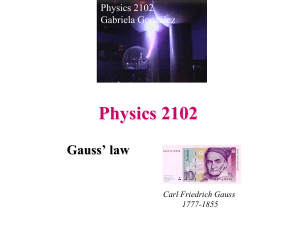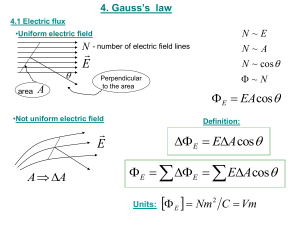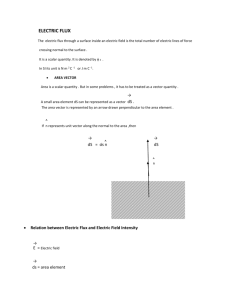Gauss`s law
advertisement
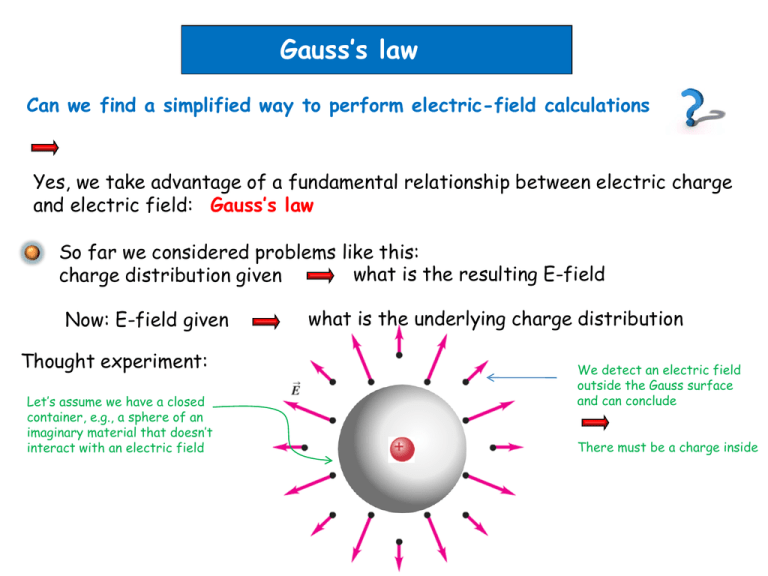
Gauss’s law Can we find a simplified way to perform electric-field calculations Yes, we take advantage of a fundamental relationship between electric charge and electric field: Gauss’s law So far we considered problems like this: what is the resulting E-field charge distribution given Now: E-field given Thought experiment: Let’s assume we have a closed container, e.g., a sphere of an imaginary material that doesn’t interact with an electric field what is the underlying charge distribution We detect an electric field outside the Gauss surface and can conclude There must be a charge inside We can even be quantitative about the charge inside the Gauss volume The same number of field lines on the surface point into the Gauss volume as there a field line pointing out We say in this case the net electric flux is zero Electric flux Flux ( from Latin fluxus meaning flow): is generally speaking the scalar quantity, , which results from a surface integration over a vector field. In the case of electric flux, E, the vector field is the electric E-field and the surface is the surface of the Gauss volume Don’t panic, we break it down into simple intuitive steps Let’s consider the intuitive velocity vector field of a fluid flowing in a pipe The flux v of the velocity vector field v through the surface of area A reads v v dA vA A A v Let’s interpret v vA A v dx v A dt Volume element of fluid which flows through surface A in time dt v vA dV dt volume flow rate through A What if we tilt A Extreme case: Flux through A is zero A v If we tilt area by an angle A v v vA cos vA v A v A A is a vector with the properties: A pointing normal to the surface A surface area Finally if surface is curved the orientation of A changes on the surface and we generalize v v A into v v d A A also change of v on the surface is taken care of The electric flux is defined in complete analogy E E dA A Let’s systematically approach the general form of Gauss’s law by considering a sequence of examples with increasing generality The electric flux of a point charge inside a Gauss sphere Spherical Gauss surface Note that the surface is closed We are going to calculate: E E dA indicates that we integrate over a closed surface The symmetry of the problem makes the integration simple: E is perpendicular to the surface and its magnitude is the same at each point of the surface Clicker question Considering the result obtained from calculating the electric flux of a point charge through a Gauss sphere. Do you expect that the flux depends on the radius of the sphere? A) Yes, the larger the radius the more flux lines will penetrate through the surface B) No, the flux is independent of the radius C) I have to calculate again for a different radius E E dA 1 Q 4 0 r 2 dA 1 Q 4 0 r 2 Q 4 r 2 0 result does not depend on the radius of the Gauss sphere More generally the result of the integral does not depend on the specific form of the surface, only on the amount of charge enclosed by the surface. For example we can calculate the flux of the enclosed charge Q through the surface of a cube z The box geometry suggests the use of Cartesian Coordinates: E ( x, y, z) y a x 1 Q 4 0 r 2 1 rˆ x, y, z Q 4 0 x y z 2 2 2 x y z 2 2 2 E E 6 E 6 dA E E d A dA E dA ... E dA d A d xd y eˆ z E dA a /2 3Q a 4 0 a/2 dx a /2 dy a /2 1 x 2 y a / 2 2 With 𝑑𝑦 𝑥2 + 𝑦2 E 𝑎 + 2 3Q a 4 0 3 2 2 = 𝑦 𝑎 𝑥2 + 2 a /2 a /2 dx 2 𝑎 𝑥2 + 𝑦2 + 2 2a a 2 x 2 2 a 2 2 x 2 2 + 𝑐𝑜𝑛𝑠𝑡 2 3/2 And with 2 adx a 2 x 2 2 E 3Q a 4 0 a 2 x 2 4 A rcTan [ x a 2x 2 a 0 3 ] const 2 2 a /2 dx a /2 2a a 2 x 2 2 a Q 0 2 x 2 2 a 2 3Q a 4 2 A rcTan 2 4 0 a 2 3 a /2 3Q 2 3Q 1 2 A rcTan 3 0 /6 Our considerations suggest: Flux through any surface enclosing the charge Q is given by Q/0 Let’s summarize findings into the general form of Gauss’s law E E dA Q enclosed 0 The total electric flux through a closed surface is equal to the total (net) electric charge inside the surface divided by 0 E q 0 E q 0 E 0 E 0 Images from our textbook Young and Freedman, University Press Electric field within a charged conductor This brief consideration prepares us for an experimental test of Gauss’s law Necessary condition for electrostatic equilibrium because otherwise charge flows without these charges -q qc+q + + + + + + + + + E=0 + + + + ++ + + ++ + + + + + + + E E dA0 Solid conductor with charge qc there would be flux through Gauss surface + + + + + + + + + + + + + ++ + + ++ + + + + + + + - - - -- -- Q enclosed 0 Gaussian surface E=0 everywhere on the surface Experimental test of Gauss’s law Clicker question Consider the conducting solid with a cavity again. We place a conducting charged sphere into the cavity and let this sphere touch the surface of the cavity. What do you expect will happen? + + + + + + A) The sphere remains charged + B) The sphere creates a dipole moment + + + + C) The charge of the sphere will flow from the + sphere and accumulate at the surface of the conducting + solid + + + + + D) The sphere will spontaneously transform into a dodecahedron E) The sphere will spontaneously transform into an icosahedron + + + + + + + +
